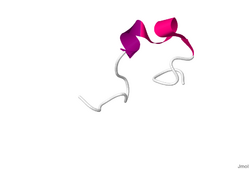Biology:Obestatin
| ghrelin/obestatin preprohormone | |
|---|---|
 | |
| Identifiers | |
| Symbol | GHRL |
| NCBI gene | 51738 |
| HGNC | 18129 |
| OMIM | 605353 |
| RefSeq | NM_016362 |
| UniProt | Q9UBU3 |
| Other data | |
| Locus | Chr. 3 p26-p25 |
Obestatin is a hormone that is produced in specialized epithelial cells of the stomach and small intestine of several animals including humans.[2] Obestatin was originally identified as an anorectic peptide, but its effect on food intake remains controversial.[3]
Discovery
Obestatin was discovered using a bioinformatics approach: by computer search of the sequenced genomes of several organisms.[4]
Structure
The obestatin structure to the right was determined by NMR. The length of the polypeptide was found to be 24 residues with a secondary structure 29% helical. Specifically 2 helices and 7 residues are formed.[1]
Gene and transcription
Obestatin is encoded by the same gene that encodes ghrelin, a peptide hormone. The mRNA produced from the GHRL gene has four exons. Five products of similar structure and function arise: the first is the 117-amino acid preproghrelin. (It is homologous to promotilin; both are members of the motilin family). It is cleaved to produce proghrelin which is cleaved to produce a 28-amino acid ghrelin (unacylated) and C-ghrelin(acylated). Obestatin is presumed to be cleaved from C-ghrelin.[5]
Receptor
It was originally proposed that GPR39 functioned as an obestatin receptor, however more recent findings suggest that this is unlikely.[6]
Blood levels
As yet no biochemical studies of circulating obestatin have been carried out.
Function
Obestatin opposes the actions of ghrelin which are growth hormone secretion and increased appetite.[3] The purpose of producing two hormones with opposing effects is not clear: removing the ghrelin gene from mice did not significantly reduce food intake. No secretory convertase is capable of cleaving the recombinant proghrelin precursor by cleavage at the single basic residue required for generation of the obestatin sequence.[7] Thus the physiological generation of this particular peptide sequence remains unproven. Obestatin has opposite action to ghrelin on food intake and plays a role in energy balance.[8] Circuit-resistance exercise resulted in a significant change in GH levels, but had no effect on plasma Obestatin levels.[9]
Clinical significance
Studies on the obestatin/ghrelin ratio in the gastrointestinal tract and plasma are associated with some diseases such as irritable bowel syndrome (IBS),[10] obesity,[11] Prader–Willi syndrome,[12] and type II diabetes mellitus.[13][14]
See also
References
- ↑ 1.0 1.1 PDB: 2JSH; "Obestatin conformational features: a strategy to unveil obestatin's biological role?". Biochem. Biophys. Res. Commun. 363 (3): 500–5. November 2007. doi:10.1016/j.bbrc.2007.08.200. PMID 17904104.
- ↑ "Lack of obestatin effects on food intake: should obestatin be renamed ghrelin-associated peptide (GAP)?". Regul. Pept. 141 (1–3): 1–7. June 2007. doi:10.1016/j.regpep.2006.12.023. PMID 17321609. https://zenodo.org/record/1259329.
- ↑ 3.0 3.1 "The ghrelin/obestatin balance in the physiological and pathological control of growth hormone secretion, body composition and food intake". J. Neuroendocrinol. 22 (7): 793–804. July 2010. doi:10.1111/j.1365-2826.2010.02019.x. PMID 20456603.
- ↑ "Obestatin, a peptide encoded by the ghrelin gene, opposes ghrelin's effects on food intake". Science 310 (5750): 996–9. November 2005. doi:10.1126/science.1117255. PMID 16284174. Bibcode: 2005Sci...310..996Z.
- Denise Grady (November 11, 2005). "In Study, Hormone Reduced Appetite in Mice". The New York Times. https://nytimes.com/2005/11/11/health/11hunger.html.
- ↑ "Ghrelin gene-related peptides: multifunctional endocrine / autocrine modulators in health and disease". Clin Exp Pharmacol Physiol 37 (1): 125–31. 2010. doi:10.1111/j.1440-1681.2009.05241.x. PMID 19566830.
- ↑ "Is GPR39 the natural receptor of obestatin?". Peptides 30 (2): 431–8. February 2009. doi:10.1016/j.peptides.2008.09.022. PMID 18977259.
- ↑ "Production of bioactive peptides in an in vitro system". Anal Biochem 366 (2): 182–9. April 2007. doi:10.1016/j.ab.2007.04.020. PMID 17540328.
- ↑ "Obestatin partially affects ghrelin stimulation of food intake and growth hormone secretion in rodents". Endocrinology 148 (4): 1648–53. 2007. doi:10.1210/en.2006-1231. PMID 17204551. PMC 1890395. http://www.hal.inserm.fr/inserm-00122945/document.
- ↑ "single circuit-resistance exercise has no effect on plasma obestatin levels in female college students". Peptides 29 (3): 487–490. 2008. doi:10.1016/j.peptides.2007.11.002. PMID 18308154.
- ↑ "Covariation of plasma ghrelin and motilin in irritable bowel syndrome". Peptides 31 (6): 1109–12. June 2010. doi:10.1016/j.peptides.2010.03.021. PMID 20338210.
- ↑ "Meta-analysis of the relationship between obestatin and ghrelin levels and the ghrelin/obestatin ratio with respect to obesity". Am. J. Med. Sci. 341 (1): 48–55. January 2011. doi:10.1097/MAJ.0b013e3181ec41ed. PMID 21139496.
- ↑ "Altered distribution of adiponectin isoforms in children with Prader-Willi syndrome (PWS): association with insulin sensitivity and circulating satiety peptide hormones". Clin. Endocrinol. 67 (6): 944–51. December 2007. doi:10.1111/j.1365-2265.2007.02991.x. PMID 17666087.
- ↑ "Circulating obestatin levels in normal subjects and in patients with impaired glucose regulation and type 2 diabetes mellitus". Clin. Endocrinol. 66 (4): 593–7. April 2007. doi:10.1111/j.1365-2265.2007.02776.x. PMID 17371480.
- ↑ "Ghrelin and obestatin levels in type 2 diabetic patients with and without delayed gastric emptying". Dig. Dis. Sci. 54 (10): 2161–6. October 2009. doi:10.1007/s10620-008-0622-2. PMID 19082715.
Further reading
- Holst B; Egerod KL; Schild E et al. (2007). "GPR39 signaling is stimulated by zinc ions but not by obestatin". Endocrinology 148 (1): 13–20. doi:10.1210/en.2006-0933. PMID 16959833.
- Obestatin, A New Physiological Opponent of Ghrelin, PHOENIX PHARMACEUTICALS, INC.
External links
- obestatin, human at the US National Library of Medicine Medical Subject Headings (MeSH)
 |

